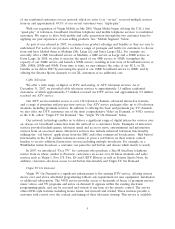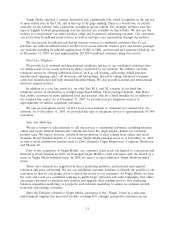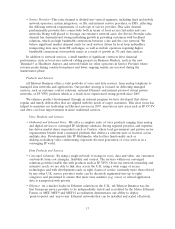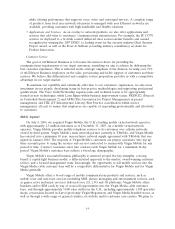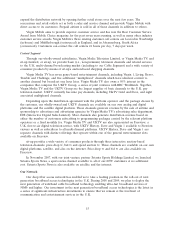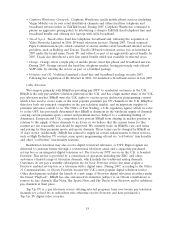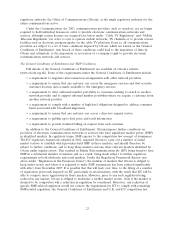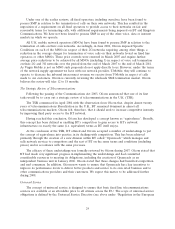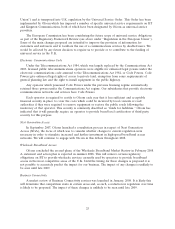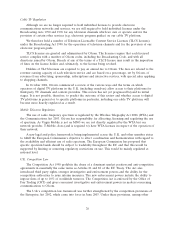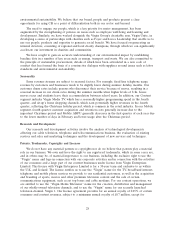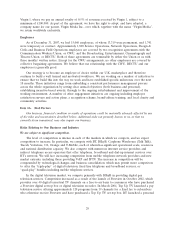Virgin Media 2007 Annual Report Download - page 21
Download and view the complete annual report
Please find page 21 of the 2007 Virgin Media annual report below. You can navigate through the pages in the report by either clicking on the pages listed below, or by using the keyword search tool below to find specific information within the annual report.During 2007, the availability of IPTV services increased as BT Vision, a combined DTT television
service and a video on demand service over a DSL broadband connection, was launched nationally and
Tiscali expanded coverage of their service beyond parts of the London metropolitan area. BSkyB also
launched a video on demand service over a DSL broadband connection and bundles that service with
its other offerings.
There are a number of new and emerging technologies which can be used to provide video services
that are likely to compete with our DTV and video on demand services. These include DSL services
mentioned above and third generation, or 3G, mobile telephony.
Telecommunications is a constantly evolving industry and we expect that there will continue to be
many advances in communications technology and in content. These advances, together with changes in
consumer behavior, and in the regulatory and competitive environments, mean that it will be difficult to
predict how our operations and businesses will be affected in the future.
The U.K. government has stated that it will terminate ATV transmission by 2012. Consumers
wishing to receive television services will have to convert to DTV, currently available via digital satellite,
DTT, DSL or cable. However, when ATV transmission is terminated, the terrestrial DTV signal and
network may be strengthened. This will enable terrestrial DTV to be made available to additional
customers’ homes that cannot currently receive a signal. It may also provide additional capacity to allow
the Freeview channel line-up to be expanded to include new channels.
There is also a growing demand and supply of full-length video content via broadband connections
to the personal computer. Content owners, online aggregators, television channel owners, etc. are
increasingly using broadband as a new digital distribution channel direct to consumers (primarily via
downloading). Current business models tend to be on a pay-per-transaction basis. This does represent a
potential disintermediation threat to pay television platforms, though the actual demand and willingness
to pay for broadband distributed content is unlikely to represent sufficient revenues and benefit to
content owners to displace pay television as a preferred distribution channel for the near future.
Broadband Internet
We provide broadband and dial-up internet services to customers within reach of our access
network by direct connection to our network. We also provide broadband and dial-up internet services
to customers not within reach of our access network by providing a connection to our network via BT’s
local access network. Our internet services compete with BT, which provides broadband and dial-up
internet access services over its own network both as a retail brand and as a wholesale service.
An increasing number of companies are deploying their own network access equipment in BT
exchanges via a process known as local loop unbundling, or LLU. LLU allows an ISP to reduce the
recurring operating costs incurred through BT Wholesale by reducing the proportion of traffic that
must travel directly over BT’s network. LLU deployment requires a substantial capital investment to
implement, and requires a large customer base to deliver a return on investment. By the end of 2007,
both Carphone Warehouse and BSkyB had rolled out significant LLU networks (with approximately
70% coverage in the United Kingdom). Other operators such as Orange and Tiscali were deploying
LLU to some degree.
BT and third party service providers use DSL technologies which, like our network, permit internet
access to be provided at substantially greater speeds than conventional dial-up access.
In addition to the increasing competition and pricing pressure in the broadband market arising as
LLU players look to gain the customer scale to make a return on their investment, there is the longer
term threat of new access technology. 3G mobile technology, other wireless technologies such as Wi-Fi
and Wi-Max, broadband power line (which utilizes existing electricity networks to deliver high-speed
19


